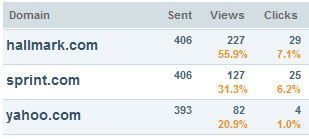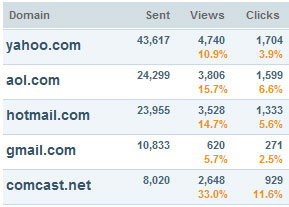One of the challenges of email marketing is that, unlike postal mail or a phone call, your message doesn’t always get delivered to your recipient. Your email deliverability – whether or not you’re being delivered to your subscribers’ inboxes – is a huge factor in what return on investment you earn from your email campaigns. After all, if the subscriber doesn’t see your email, they can’t act on it, right?
One of the benefits of email marketing is that, like all digital marketing, it comes equipped with analytics and reporting that can talk to you about the status of your campaigns. One of the most important set of metrics to watch is your results by domain. Domain-level reporting allows you to see the open rate (views), click through rate, bounce rate, unsubscribe rate and complaint rate, not just of your email as a whole, but also across each receiving domain.
Looking at your open rate by domain, for example, will give you warning signs that your email didn’t make it to the inbox. If your overall open rate for an email was 23% but only 6% of your Yahoo! subscribers opened, you probably had some delivery issues at Yahoo!. It’s possible, your subscribers are getting the emails, but aren’t turning on images for some reason. (An open is logged when images load in your email.)
More likely, though, your low open rate at Yahoo! is because your emails were sent to Junk or weren’t delivered at all. Email clients like Gmail, AOL and Yahoo! put their inbox users first. They don’t have to deliver your email and they aren’t required to tell you, the sender, if they don’t. Significant differences in open or click through rates is a pretty good sign of deliverability problems.
Another key metric to watch is your bounce rate by domain. If you see a 60% soft bounce rate at Hotmail, then chances are high that Hotmail is telling you they’re keeping you out of its inboxes. It’s nice of them to tell you – at least now you know – but too bad that your email didn’t get through. If you’re sending regularly to a clean list, an overall bounce rate of 2-3% is average. A bounce rate consistently above 5% needs attention and if any of your receiving domains show twice the bounce rate of the rest of the list, it’s a huge red flag.
For most Business-to-Consumer email marketers, the number one domain to watch is Yahoo!, which usually makes up 20-40% of their list. The next largest segments are usually some combination of AOL, Gmail and Hotmail. Working with those email clients to monitor and ensure delivery is a regular part of any B2C email marketing campaign.
 Business-to-Business email marketers work with corporate domains and so don’t usually have any one domain that makes up 40% of their list. They may not be able to resolve the majority of their deliverability issues through one email client or ISP, but they can and should work with the IT teams at companies where a large number of employees subscribe. For the United Way of Greater Kansas City, email addresses from the top 20 donor companies make up almost 50% of their email list. When they see abnormal metrics at any of these top domains, they know they have work to do to get past desktop and server-level Spam filters to be sure their top donors are hearing from them.
Business-to-Business email marketers work with corporate domains and so don’t usually have any one domain that makes up 40% of their list. They may not be able to resolve the majority of their deliverability issues through one email client or ISP, but they can and should work with the IT teams at companies where a large number of employees subscribe. For the United Way of Greater Kansas City, email addresses from the top 20 donor companies make up almost 50% of their email list. When they see abnormal metrics at any of these top domains, they know they have work to do to get past desktop and server-level Spam filters to be sure their top donors are hearing from them.
Are you reviewing your results by domain? The one-two punch in monitoring your deliverability by domain is reviewing domain-level results for all of your email campaigns and seeding your list with email addresses at all your most important domains. For our clients, emfluence partners with Return Path to use their seed list of over 700 email addresses to monitor message placement and keep an eye out for trouble.
To review your deliverability with an emfluence expert, email or call us at 877-81-EMAIL (877-813-6245).




